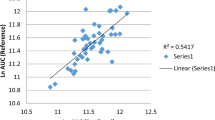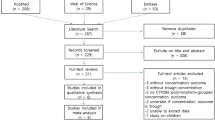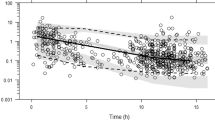Abstract
Virologic failure of antiretroviral therapy (ART) may be explained by single nucleotide polymorphisms (SNPs) in drug absorption and metabolism genes. Here, we characterized the associations between polymorphisms in cytochrome P450 enzymes’ genes CYP2B6 and CYP3A4/A5, nuclear receptor genes NR1I2/3, and initial ART efficacy among 203 HIV-positive individuals from Rio de Janeiro. Association between SNPs and virologic control was evaluated after 6 and 12 months of follow-up using Cox regression models. The SNP rs2307424 (NR1I3) was associated with increased virologic response after 12 months of treatment, while rs1523127 (NR1I2), rs3003596, and rs2502815 (NR1I3) were associated with decreased response. Increased virologic response after 12 months (adjHR = 1.54; p = 0.02) was also observed among carriers of the NR1I3 haplotype rs2502815G-rs3003596A-rs2307424A versus the reference haplotype G-A-G. Our results suggest that NR1I2 and NR1I3 variants are associated with virologic responses to ART among Brazilians.
This is a preview of subscription content, access via your institution
Access options
Subscribe to this journal
Receive 6 print issues and online access
$259.00 per year
only $43.17 per issue
Buy this article
- Purchase on Springer Link
- Instant access to full article PDF
Prices may be subject to local taxes which are calculated during checkout
Similar content being viewed by others
References
UNAIDS. Global HIV statistics. 2019. https://www.unaids.org/sites/default/files/media_asset/UNAIDS_FactSheet_en.pdf. Access: 28/12/2020.
Pádua CA, César CC, Bonolo PF, Acurcio FA, Guimarães MD. Self-reported adverse reactions among patients initiating antiretroviral therapy in Brazil. Braz J Infect Dis. 2007;11:20–6.
Yuan Y, L’Italien G, Mukherjee J, Iloeje UH. Determinants of discontinuation of initial highly active antiretroviral therapy regimens in a US HIV-infected patient cohort. HIV Med. 2006;7:156–62.
Cardoso SW, Grinsztejn B, Velasque L, Veloso VG, Luz PM, Friedman RK, et al. Incidence of modifying or discontinuing first HAART regimen and its determinants in a cohort of HIV-infected patients from Rio de Janeiro, Brazil. AIDS Res Hum Retroviruses. 2010;26:865–74.
Ribeiro FA, Tupinambás U, Fonseca MO, Greco DB. Durability of the first combined antiretroviral regimen in patients with AIDS at a reference center in Belo Horizonte, Brazil, from 1996 to 2005. Braz J Infect Dis. 2012;16:27–33.
De La Torre-Lima J, Aguilar A, Santos J, Jiménez-Oñate F, Marcos M, Núñez V, et al. Durability of the first antiretroviral treatment regimen and reasons for change in patients with HIV infection. HIV Clin Trials. 2014;15:27–35.
Grangeiro A, Escuder MM, Cassanote AJF, Souza RA, Kalichman AO, Veloso V, et al. The HIV-Brazil Cohort study: design, methods and participant characteristics. PLoS ONE 2014;9:e95673. https://doi.org/10.1371/journal.pone.0095673.
Bandeira ACPCS, Elias DBD, Cavalcante MG, Lima DGL, Távora LGF. Antiretroviral changes during the first year of therapy. Rev Assoc Med Bras. 2017;63:606–12.
Cordell HJ, Clayton DG. Genetic association studies. Lancet. 2005;366:1121–31.
Kozyra M, Ingelman-Sundberg M, Lauschke VM. Rare genetic variants in cellular transporters, metabolic enzymes, and nuclear receptors can be important determinants of interindividual differences in drug response. Genet Med. 2017;19:20–9.
Lauschke VM, Milani L, Ingelman-Sundberg M. Pharmacogenomic biomarkers for improved drug therapy—recent progress and future developments. AAPS J. 2018;20:4.
Erickson DA, Mather G, Trager WF, Levy RH, Keirns JJ. Characterization of the in vitro biotransformation of the HIV-1 reverse transcriptase inhibitor nevirapine by human hepatic cytochromes P-450. Drug Metab Dispos. 1999;27:1488–95.
Ward BA, Gorski JC, Jones DR, Hall SD, Flockhart DA, Desta Z. The cytochrome P450 2B6 (CYP2B6) is the main catalyst of efavirenz primary and secondary metabolism: implication for HIV/AIDS therapy and utility of efavirenz as a substrate marker of CYP2B6 catalytic activity. J Pharm Exp Ther. 2003;306:287–300.
Zhou S-F. Drugs behave as substrates, inhibitors and inducers of human cytochrome P450 3A4. Curr Drug Metab. 2008;9:310–22.
Haas DW, Ribaudo HJ, Kim RB, Tierney C, Wilkinson GR, Gulick RM, et al. Pharmacogenetics of efavirenz and central nervous system side effects: an Adult AIDS Clinical Trials Group study. Aids. 2004;18:2391–400.
Haas DW, Smeaton LM, Shafer RW, Robbins GK, Morse GD, Labbé L, et al. Pharmacogenetics of long‐term responses to antiretroviral regimens containing efavirenz and/or nelfinavir: an Adult AIDS Clinical Trials Group Study. J Infect Dis. 2005;192:1931–42.
Oluka MN, Okalebo FA, Guantai AN, McClelland RS, Graham SM. Cytochrome P450 2B6 genetic variants are associated with plasma nevirapine levels and clinical response in HIV-1 infected Kenyan women: a prospective cohort study. AIDS Res Ther. 2015;12:1–9.
Griffin L, Annaert P, Brouwer KLR. Influence of drug transport proteins on the pharmacokinetics and drug interactions of HIV protease inhibitors. J Pharm Sci. 2011;100:3636–54.
Emmelkamp JM, Rockstroh JK. CCR5 antagonists: comparison of efficacy, side effects, pharmacokinetics and interactions-review of the literature. Eur J Med Res. 2007;12:409–17.
Schuetz EG, Schuetz JD, Grogan WML, Naray-Fejes-Toth A, Fejes-Toth G, Raucy J, et al. Expression of cytochrome P450 3A in amphibian, rat, and human kidney. Arch Biochem Biophys. 1992;294:206–14.
Michaud V, Bar-Magen T, Turgeon J, Flockhart D, Desta Z, Wainberg MA. The dual role of pharmacogenetics in HIV treatment: mutations and polymorphisms regulating antiretroviral drug resistance and disposition. Pharm Rev. 2012;64:803–33.
Wang H, LeCluyse EL. Role of orphan nuclear receptors in the regulation of drug-metabolising enzymes. Clin Pharmacokinet. 2003;42:1331–57.
Chen Y, Tang Y, Guo C, Wang J, Boral D, Nie D. Nuclear receptors in the multidrug resistance through the regulation of drug-metabolizing enzymes and drug transporters. Biochem Pharmacol. 2012;83:1112–26. https://doi.org/10.1016/j.bcp.2012.01.030.
Zhang J, Kuehl P, Green ED, Touchman JW, Watkins PB, Daly A, et al. The human pregnane X receptor: genomic structure and identification and functional characterization of natural allelic variants. Pharmacogenetics. 2001;11:555–72.
Zordoky B, El-Kadi A. Role of NF-κB in the regulation of cytochrome P450 enzymes. Curr Drug Metab. 2009;10:164–78.
Faucette SR, Zhang TC, Moore R, Sueyoshi T, Omiecinski CJ, LeCluyse EL, et al. Relative activation of human pregnane X receptor versus constitutive androstane receptor defines distinct classes of CYP2B6 and CYP3A4 inducers. J Pharm Exp Ther. 2007;320:72–80.
Svärd J, Spiers JP, Mulcahy F, Hennessy M. Nuclear receptor-mediated induction of CYP450 by antiretrovirals: functional consequences of NR1I2 (PXR) polymorphisms and differential prevalence in whites and sub-Saharan Africans. J Acquir Immune Defic Syndr. 2010;55:536–49.
Hariparsad N, Nallani SC, Sane RS, Buckley DJ, Buckley AR, Desai PB. Induction of CYP3A4 by efavirenz in primary human hepatocytes: comparison with rifampin and phenobarbital. J Clin Pharm. 2004;44:1273–81.
Faucette SR, Sueyoshi T, Smith CM, Negishi M, Lecluyse EL, Wang H. Differential regulation of hepatic CYP2B6 and CYP3A4 genes by constitutive androstane receptor but not pregnane X receptor. J Pharm Exp Ther. 2006;317:1200–9.
Suarez-Kurtz G. Pharmacogenetics in the Brazilian population. Front Pharmacol. 2010;1:118.
Arruda MB, Campagnari F, De Almeida TB, Couto-Fernandez JC, Tanuri A, Cardoso CC. Single nucleotide polymorphisms in cellular drug transporters are associated with intolerance to antiretroviral therapy in brazilian HIV-1 positive individuals. PLoS ONE. 2016;11:e0163170.
de Almeida TB, de Azevedo MCVM, C Pinto JFDA, A Ferry FRDE, da Silva GAR, de Castro IJ, et al. Drug metabolism and transport gene polymorphisms and efavirenz adverse effects in Brazilian HIV-positive individuals. J Antimicrob Chemother. 2018;73:2460–7.
Bosch TM, Deenen M, Pruntel R, Smits PHM, Schellens JHM, Beijnen JH, et al. Screening for polymorphisms in the PXR gene in a Dutch population. Eur J Clin Pharm. 2006;62:395–9.
Sarfo FS, Zhang Y, Egan D, Tetteh LA, Phillips R, Bedu-Addo G, et al. Pharmacogenetic associations with plasma efavirenz concentrations and clinical correlates in a retrospective cohort of ghanaian HIV-infected patients. J Antimicrob Chemother. 2014;69:491–9.
Sharma D, Lau AJ, Sherman MA, Chang TKH. Agonism of human pregnane X receptor by rilpivirine and etravirine: comparison with first generation non-nucleoside reverse transcriptase inhibitors. Biochem Pharm. 2013;85:1700–11.
Wang ZP, Zhao M, Qu QS, Miao SZ. Effect of pregnane X receptor polymorphisms on tacrolimus blood concentrations and the resulting adverse reactions in kidney transplantation recipients. Genet Mol Res. 2016;15:gmr.15038464.
Nebert DW, Jorge-Nebert L, Vesell ES. Pharmacogenomics and ‘individualized drug therapy’: high expectations and disappointing achievements. Am J Pharmacogenomics. 2003;3:361–70.
Naslavsky MS, Yamamoto GL, de Almeida TF, Ezquina SAM, Sunaga DY, Pho N, et al. Exomic variants of an elderly cohort of Brazilians in the ABraOM database. Hum Mutat. 2017;38:751–63.
Moreira RPP, Jorge AAL, Mendonca BB, Bachega TASS. Frequency of genetic polymorphisms of PXR gene in the Brazilian population. Clinics. 2011;66:1041–4.
Long T, Klein K, Fischer J, Nussler AK, Neuhaus P, Hofmann U. et al. Extensive genetic polymorphism in the human CYP2B6 gene with impact on expression and function in human liver. Pharmacogenetics. 2001;11:399–415.
Holzinger ER, Grady B, Ritchie MD, Ribaudo HJ, Acosta EP, Morse GD, et al. Genome-wide association study of plasma efavirenz pharmacokinetics in AIDS Clinical Trials Group protocols implicates several CYP2B6 variants. Pharmacogenet Genomics. 2012;22:858–67.
Wyen C, Hendra H, Vogel M, Hoffmann C, Knechten H, Brockmeyer NH, et al. Impact of CYP2B6 983T>C polymorphism on non-nucleoside reverse transcriptase inhibitor plasma concentrations in HIV-infected patients. J Antimicrob Chemother. 2008;61:914–8.
Ribaudo HJ, Liu H, Schwab M, Schaeffeler E, Eichelbaum M, Motsinger‐Reif AA, et al. Effect of CYP2B6, ABCB1, and CYP3A5 polymorphisms on efavirenz pharmacokinetics and treatment response: an AIDS Clinical Trials Group Study. J Infect Dis. 2010;202:717–22.
Wyen C, Hendra H, Siccardi M, Platten M, Jaeger H, Harrer T, et al. Cytochrome P450 2B6 (CYP2B6) and constitutive androstane receptor (CAR) polymorphisms are associated with early discontinuation of efavirenz-containing regimens. J Antimicrob Chemother. 2011;66:2092–8.
Sánchez Martín A, Cabrera Figueroa S, Cruz Guerrero R, Hurtado LP, Hurlé AD, Carracedo Álvarez A. et al. Impact of pharmacogenetics on CNS side effects related to efavirenz. Pharmacogenomics. 2013;14:1167–78.
Lee SS, To KW, Lee MP, Wong NS, Chan DPC, Li PCK. et al.Sleep quality in efavirenz-treated Chinese HIV patients – comparing between GT and GG genotype of CYP2B6-516 G / T polymorphisms.Int J STD AIDS. 2015;25:193–200.
Coelho AVC, Silva SPS, De Alencar LCA, Stocco G, Crovella S, Brandão LAC, et al. ABCB1 and ABCC1 variants associated with virological failure of first]line protease inhibitors antiretroviral regimens in northeast Brazil patients. J Clin Pharm. 2013;53:1286–93.
King CR, Xiao M, Yu J, Minton MR, Addleman NJ, Van Booven DJ, et al. Identification of NR1I2 genetic variation using resequencing. Eur J Clin Pharm. 2007;63:547–54.
Lamba J, Lamba V, Strom S, Venkataramanan R, Schuetz E. Novel single nucleotide polymorphisms in the promoter and intron 1 of human pregnane X receptor/NR1I2 and their association with CYP3A4 expression. Drug Metab Dispos. 2008;36:169–81.
Wang XD, Li JL, Su QB, Guan S, Chen J, Du J, et al. Impact of the haplotypes of the human pregnane X receptor gene on the basal and St John’s wort-induced activity of cytochrome P450 3A4 enzyme. Br J Clin Pharm. 2009;67:255–61.
Sinxadi PZ, Leger PD, McIlleron HM, Smith PJ, Dave JA, Levitt NS, et al. Pharmacogenetics of plasma efavirenz exposure in HIV-infected adults and children in South Africa. Br J Clin Pharm. 2015;80:146–56.
Swart M, Whitehorn H, Ren Y, Smith P, Ramesar RS, Dandara C. PXR and CAR single nucleotide polymorphisms influence plasma efavirenz levels in South African HIV/AIDS patients. BMC Med Genet. 2012;13:1–12.
Olagunju A, Bolaji O, Amara A, Waitt C, Else L, Adejuyigbe E, et al. Breast milk pharmacokinetics of efavirenz and breastfed infants’ exposure in genetically defined subgroups of mother–infant pairs: an observational study. Clin Infect Dis. 2015;61:453–63.
Swart M, Evans J, Skelton M, Castel S, Wiesner L, Smith PJ, et al. An expanded analysis of pharmacogenetics determinants of efavirenz response that includes 3′-UTR single nucleotide polymorphisms among black South African HIV/AIDS patients. Front Genet 2016;6:356. https://doi.org/10.3389/fgene.2015.00356.
Ayuso P, Neary M, Chiong J, Owen A. Meta-analysis of the effect of CYP2B6, CYP2A6, UGT2B7 and CAR polymorphisms on efavirenz plasma concentrations. J Antimicrob Chemother. 2019;74:3281–90.
Cortes CP, Siccardi M, Chaikan A, Owen A, Zhang G, Porte CJLL. Correlates of efavirenz exposure in chilean patients affected with human immunodeficiency virus reveals a novel association with a polymorphism in the constitutive androstane receptor. Ther Drug Monit. 2013;35:78–83.
Arab-Alameddine M, Di Iulio J, Buclin T, Rotger M, Lubomirov R, Cavassini M, et al. Pharmacogenetics-based population pharmacokinetic analysis of efavirenz in HIV-1-infected individuals. Clin Pharm Ther. 2009;85:485–94.
Ministério da Saúde do Brasil, Secretaria de Vigilância em Saúde, Departamento de DST AIDS e Hepatites Virais. Relatório de Monitoramento Clínico do HIV. 2020. http://www.aids.gov.br/system/tdf/pub/2016/67463/relatorio.pdf?file=1&type=node&id=67463&force=1. Access: 28/12/2020.
Arruda MB, Boullosa LT, Cardoso CC, da Costa CM, Brites C, de Lima STS, et al. Brazilian network for HIV drug resistance surveillance (HIV-BresNet): a survey of treatment-naive individuals. J Int AIDS Soc. 2018;21:e25032. https://doi.org/10.1002/jia2.25032.
Lins TC, Vieira RG, Abreu BS, Grattapaglia D, Pereira RW. Genetic composition of Brazilian population samples based on a set of twenty eight ancestry informative SNPs. Am J Hum Biol. 2010;22:187–92.
Saloum de Neves Manta F, Pereira R, Vianna R, Rodolfo Beuttenmüller de Araújo A, Leite Góes Gitaí D, Aparecida da Silva D. et al. Revisiting the genetic ancestry of Brazilians using autosomal AIM-indels. PLoS ONE. 2013;8:e75145.
Therneau TM, Grambsch PM. Modeling survival data: extending the Cox model. Springer New York: New York, NY; 2000. https://doi.org/10.1007/978-1-4757-3294-8.
Grambsch PM, Therneau TM. Proportional hazards tests and diagnostics based on weighted residuals. Biometrika. 1994;81:515.
Lehmann EL, Casella G. Theory of point estimation. Springer-Verlag: New York; 1998. https://doi.org/10.1007/b98854.
Acknowledgements
We are grateful to David W. Haas, MD, from Vanderbilt University, for his thoughtful comments and suggestions. This study was supported by grants from The Brazilian Ministry of Health (TC 235/2012 to C.C.C.), Conselho Nacional de Desenvolvimento Científico e Tecnológico (CNPq; grant number 480753/2013-0 to C.C.C.), Fundação de Amparo à Pesquisa do Estado do Rio de Janeiro (FAPERJ; grant number E-26/202.791/2019 to C.C.C.), and Fundação Oswaldo Cruz – Programa INOVA (18801948377 to M.R.A.). C.A.V. is recipient of a graduate fellowship from FAPERJ.
Author information
Authors and Affiliations
Contributions
S.S.S. and C.C.C. were responsible for study design. C.A.V., T.B.A., I.E., S.L., and L.P. conducted the experiments. C.A.V., M.R.A., and C.C.C. analyzed the data. M.C.V.M.A. and J.F.C.P. were responsible for subject’s recruitment and clinical follow-up. L.P., A.T., and C.C.C. financed the study. C.A.V., M.R.A., and C.C.C. wrote the manuscript.
Corresponding author
Ethics declarations
Competing interests
The authors declare no competing interests.
Ethics statement
This study was approved by the Research Ethics Committee of Hospital Universitário Gaffreé e Guinle, number 94/2011. Written informed consent was obtained from all participants. All procedures were performed in accordance with the Helsinki Declaration.
Additional information
Publisher’s note Springer Nature remains neutral with regard to jurisdictional claims in published maps and institutional affiliations.
Supplementary information
Rights and permissions
About this article
Cite this article
de Almeida Velozo, C., de Almeida, T.B., de Azevedo, M.C.V.M. et al. Polymorphisms at CYP enzymes, NR1I2 and NR1I3 in association with virologic response to antiretroviral therapy in Brazilian HIV-positive individuals. Pharmacogenomics J 22, 33–38 (2022). https://doi.org/10.1038/s41397-021-00254-4
Received:
Revised:
Accepted:
Published:
Issue Date:
DOI: https://doi.org/10.1038/s41397-021-00254-4



